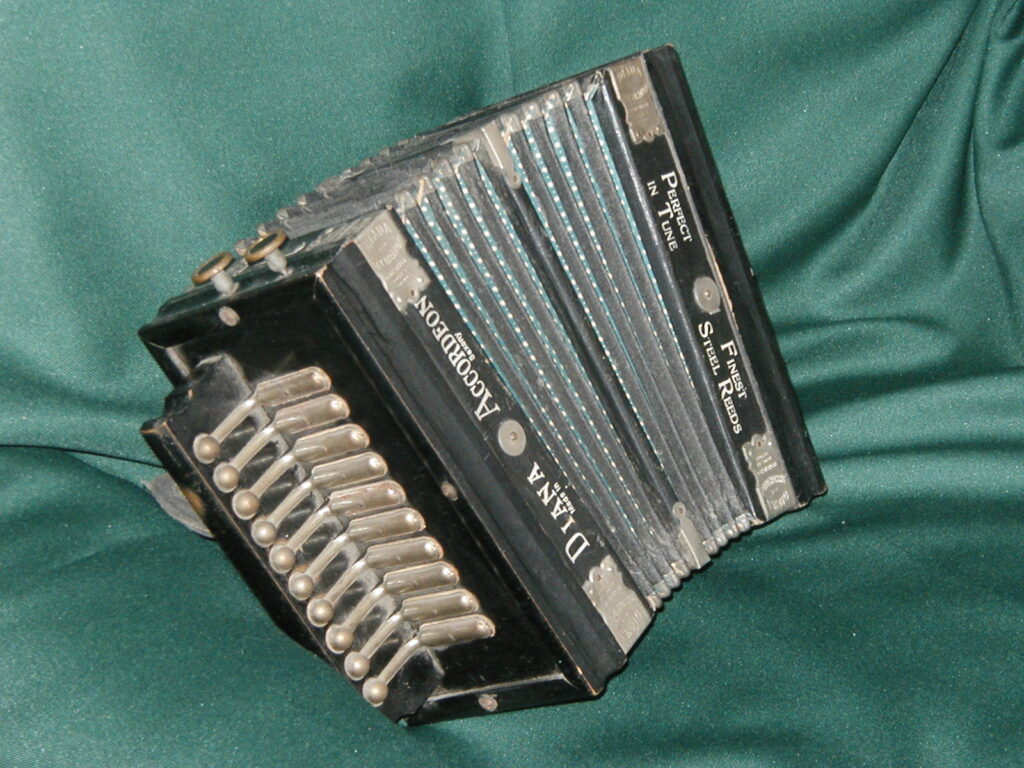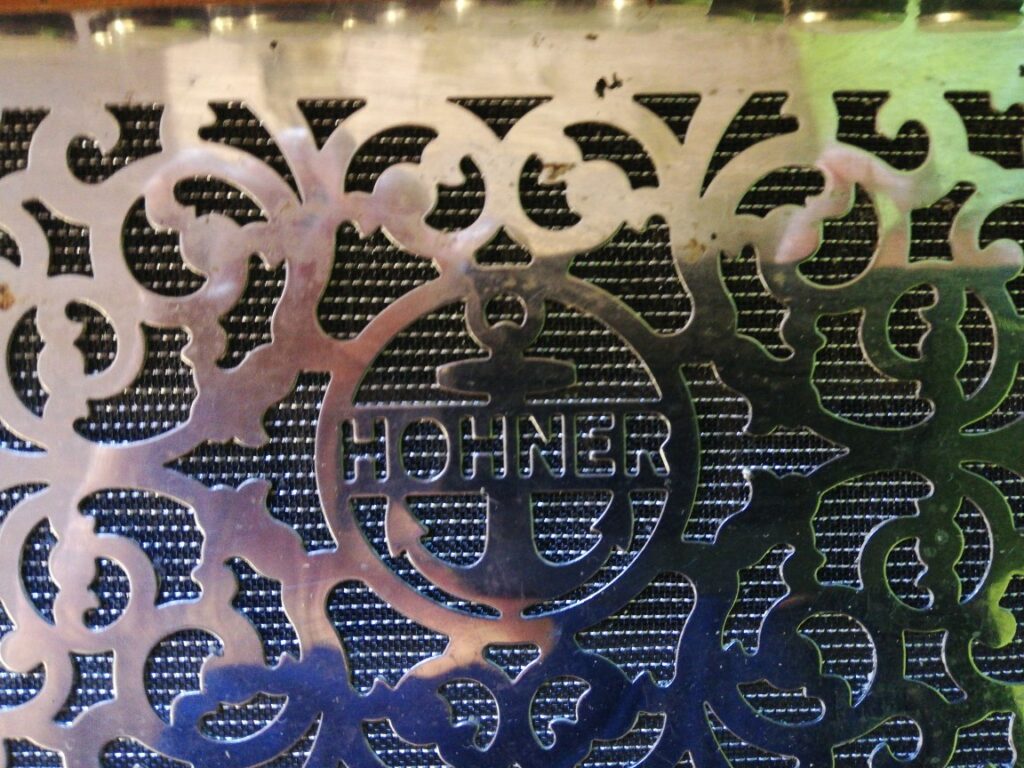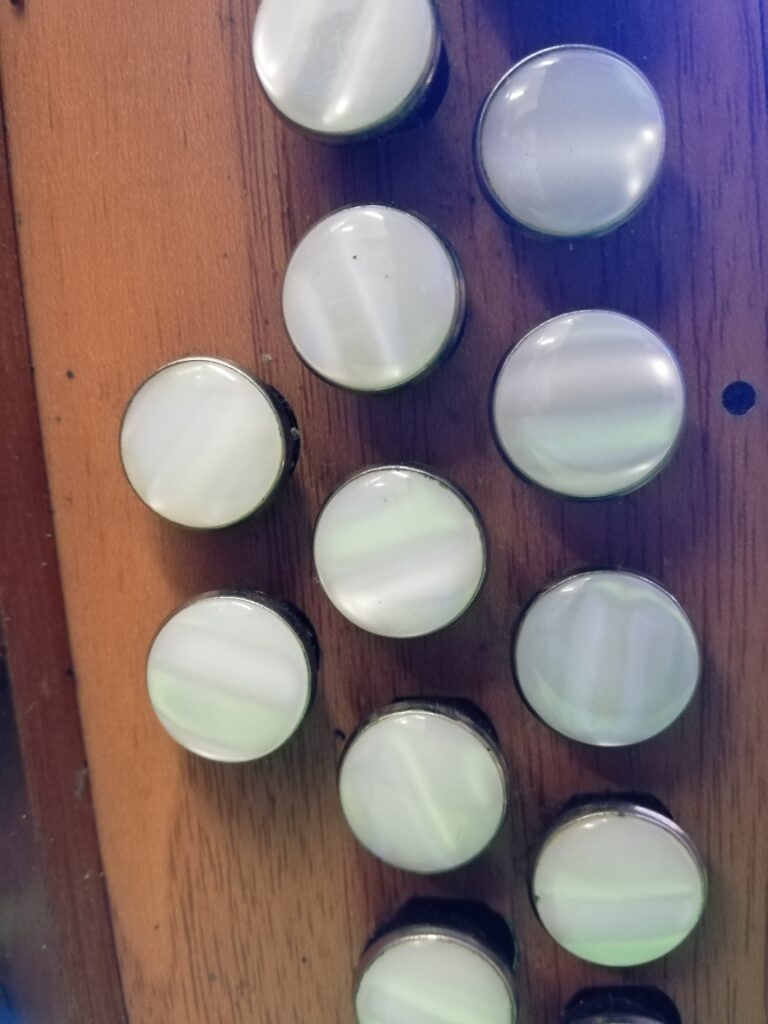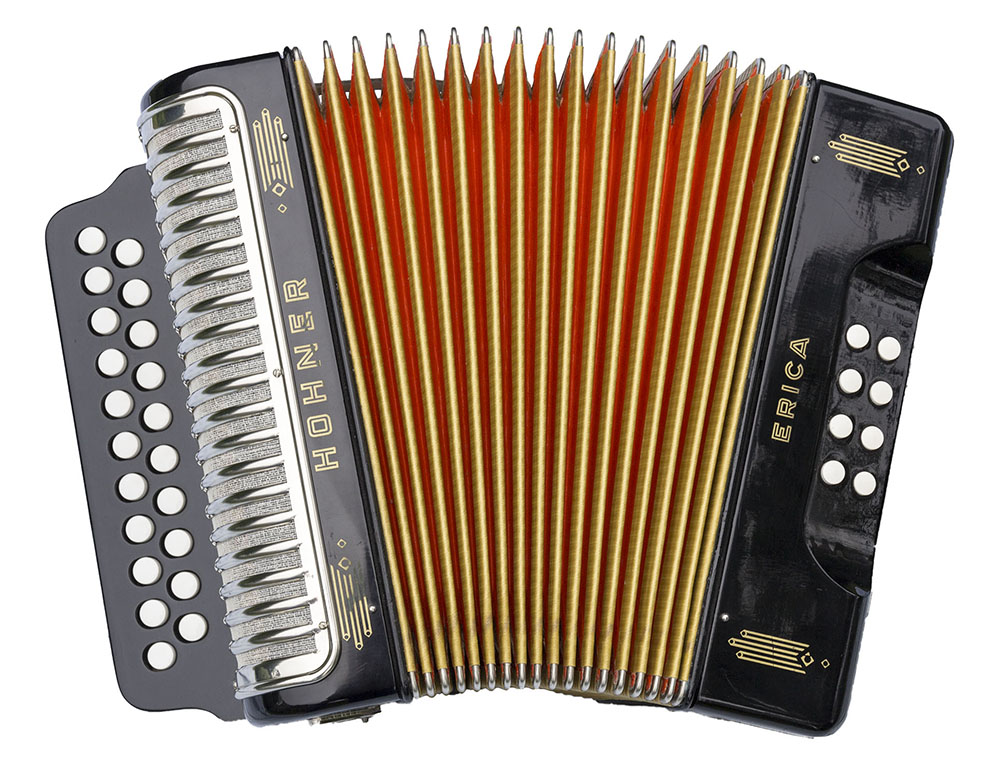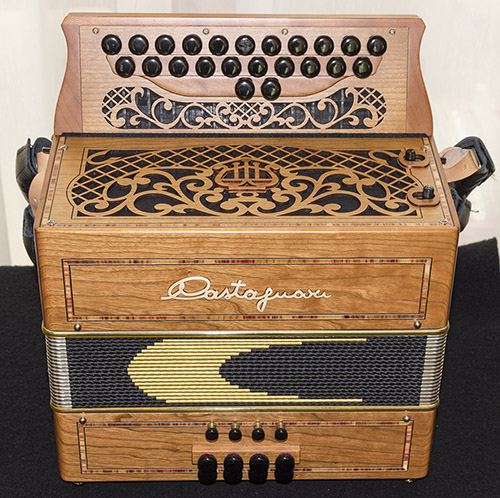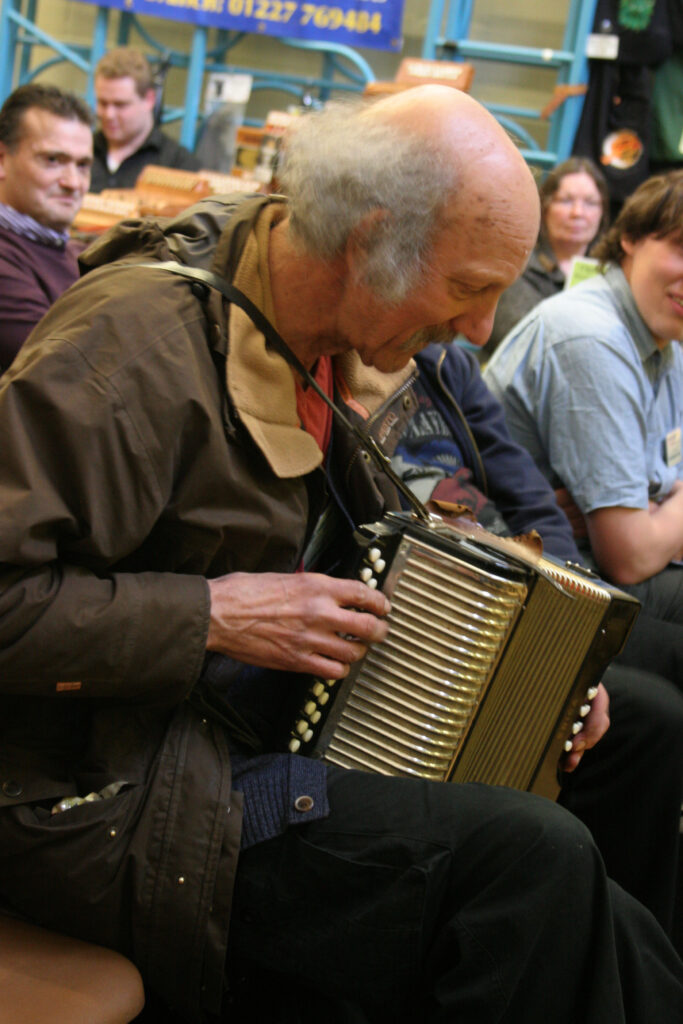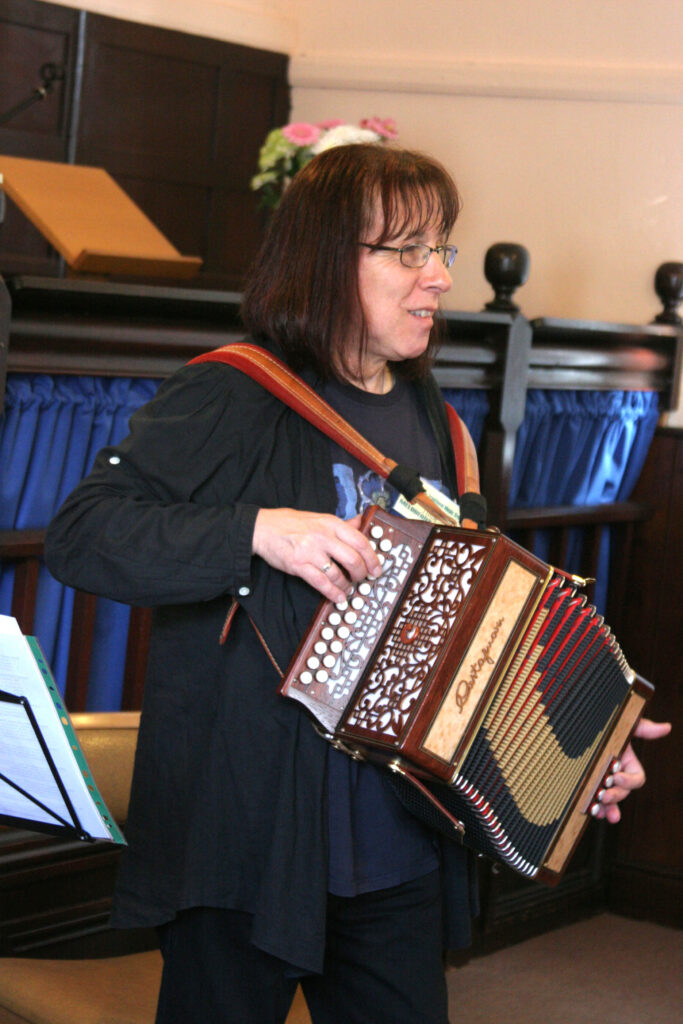Photo credit EATMT
by Steve Dumpleton
including contributions from Alex Bartholomew and the EATMT archives.
The melodeon is a type of small accordion, with rows of buttons rather than piano keys, and has become a popular instrument for traditional East Anglian music. Invented and developed in what is now Germany during the first half of the 19th century, it is a relative newcomer to the tradition, compared say with the fiddle, flute and dulcimer, but it is hard to imagine East Anglian music without it. Its compact size and relatively light weight makes it ideal for playing dance music, whether for accompanying solo step-dancing, playing for dances in a village hall, or simply for enjoying tunes at home or in a pub session.
The term ‘melodeon’ is now commonly used in England for instruments with one, two or more rows of buttons, but many of the older East Anglian players referred to their instruments as an ‘accordion’. In Ireland, a ‘melodeon’ specifically means an instrument with a single row of buttons, the two-row instrument being termed a ‘button accordion’, as is also the case in Scotland. The French name is ‘accordéon diatonique’, which gives a clue about how the instrument works. For now, we will refer to the instrument as a melodeon, and will describe the two-row and one-row instruments.
How it works
All melodeons have a ‘treble end’ keyboard on the right-hand side, with buttons which can be pressed by the right-hand fingers. The thumb is rarely used to press the buttons but helps support the instrument either by bracing it along the keyboard edge, or else gripping behind the keyboard.
The left-hand end of the instrument has fewer buttons. These provide the bass notes and chords, which can be very effectively used for an ‘oom-pah’ style of accompaniment. One-row melodeons usually have just two or four buttons, or sometimes ‘spoon-bass’ keys. Two row instruments commonly have eight or twelve buttons on the left-hand side.
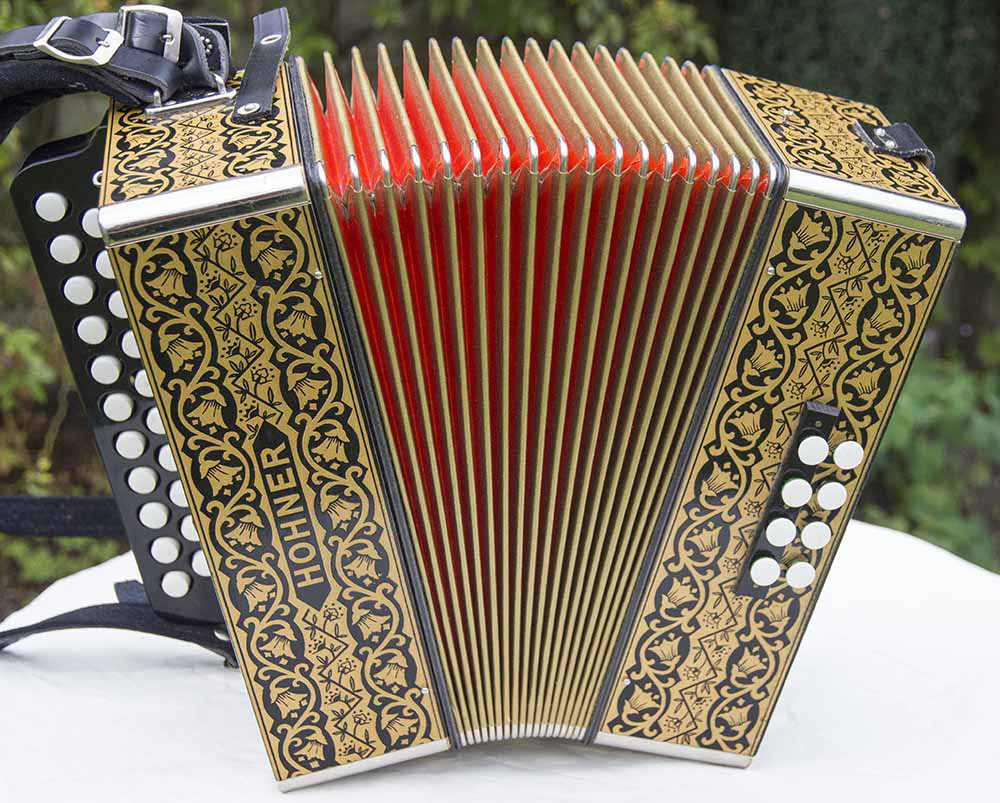
A Hohner ‘Pokerwork’ melodeon in D/G, made in Germany.
A favourite with beginners and professionals alike. A real workhorse!
Photo credit S Dumpleton
Connecting the two ends is a set of bellows, typically around 18 folds, and constructed of card, paper and leather. When the bellows are pushed or pulled, and a button is depressed, air is forced through a reed, which normally consists of a thin springy steel tongue riveted at one end to an aluminium or zinc frame with a slot in which the reed tongue can vibrate. Each time the reed vibrates, a small pulse of air is released through the slot. It is this stream of air pulses which creates the sound which we hear, rather than the vibration of the reed tongue itself (which can only produce a quiet ‘twang’ sound). Longer reeds produce a low-pitched note, smaller reeds produce higher notes, and the reeds can be tuned during manufacture to produce all the notes required for the instrument.
There are separate reeds for the push notes and pull notes, and the most characteristic feature of the melodeon (and its cousins the anglo concertina and mouth-organ) is that the reeds are tuned so that each button plays two different notes on the push and on the pull.
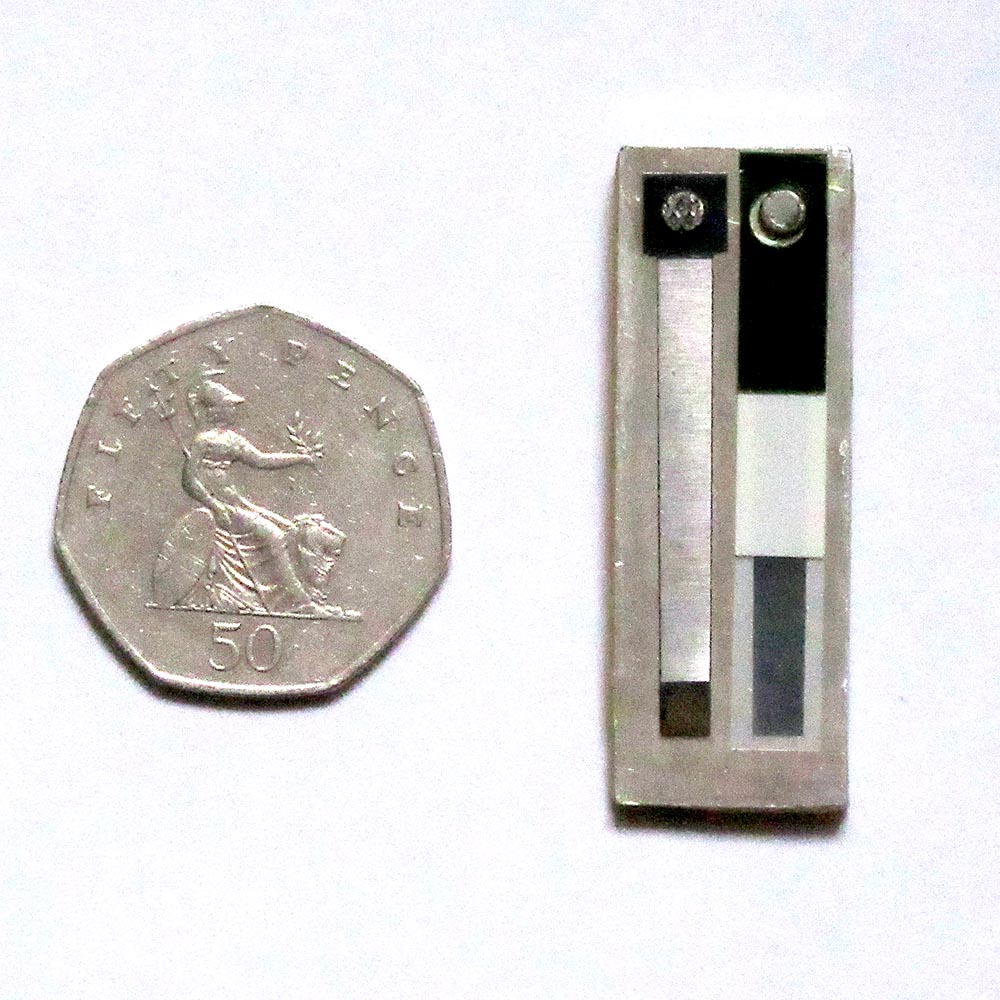
A reed plate from a Hohner melodeon with 50p coin for scale. The ‘push’ reed tongue is on the left of the reed plate; the vinyl valve is on the right, covering the slot and the underneath ‘pull’ reed.
Photo credit S Dumpleton
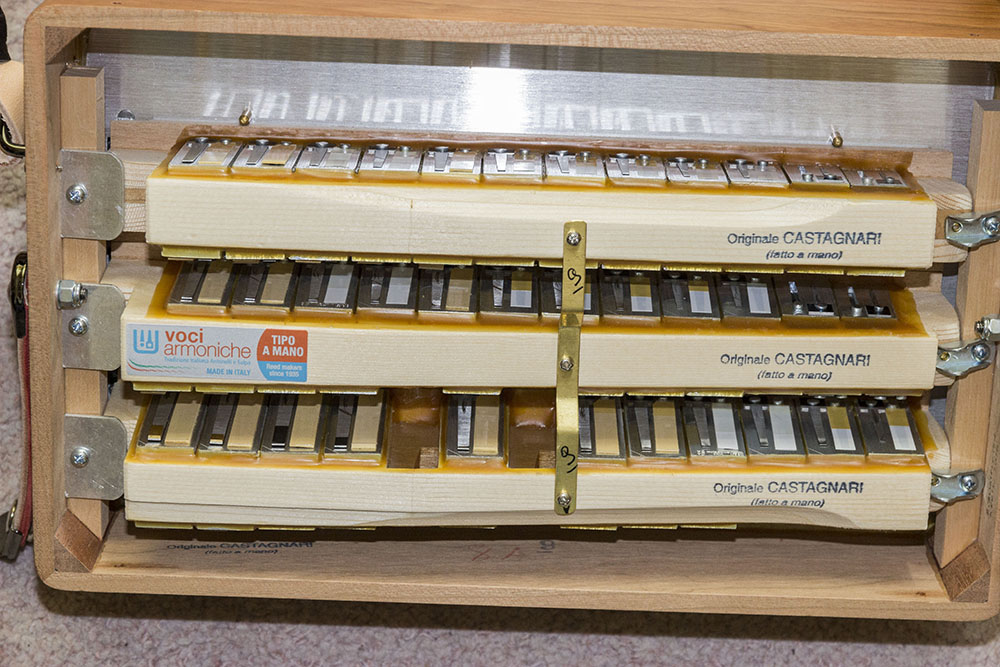
Interior view of a Castagnari ‘1914’ melodeon, showing the treble-end reed blocks
carrying the various banks of reeds.
Photo credit S Dumpleton
The buttons are arranged to play a basic ‘doh, re, mi…. etc.’ major scale by alternately pushing and pulling along the length of the keyboard. This type of scale is known as a diatonic scale, hence the French name for the instrument mentioned above.
Tuning systems
The right-hand treble end of a two-row melodeon will have the inside row of buttons tuned to one diatonic scale, e.g. G major on a D/G melodeon, and the outer row of buttons tuned a fourth lower, i.e. D major on a D/G melodeon. The D/G melodeon is a relatively modern tuning, having been introduced by Peter Kennedy in the 1950s, and is now probably the most popular in England, but two-row melodeons in earlier tunings of C/F, A/D and G/C are also available, the latter particularly for French music. There are also semitone-tuned instruments tuned typically to C/C# or B/C. The latter is particularly favoured for Irish and Scottish music. More information about the rise of the D/G melodeon can be found here:
http://forum.melodeon.net/index.php/topic,19434.msg235907.html#msg235907
Although most fourth-apart tuned melodeons also have a pair of buttons tuned to accidentals (sharps and flats not in the main scales of the rows), the instruments are only partially chromatic – the full range of notes including all sharps and flats is not available. At first this seems like a disadvantage, but the push-pull diatonic layout means that the instrument is extraordinarily compact; a full octave is achieved every four buttons on the bellows push and every five buttons on the bellows pull. Pushing the bellows with any group of buttons will always produce notes in a chord of G or D (or whatever the tuning is), so it is easy to play right-hand harmonies. Also, when playing a tune, if you accidentally press the ‘wrong button’, the resulting note will nearly always harmonise!
A characteristic of the diatonic push-pull system is the wonderful rhythmic drive which it imparts to the music. Add to this the ‘oom-pah’ action of the basses and chords, which are tuned to coordinate with the right-hand buttons, and the melodeon is indeed a real ‘band in a box’, and just right for those East Anglian polkas, hornpipes, jigs, schottisches and waltzes!
Two-row and one-row melodeons in the East Anglian tradition
The main types of melodeons used in East Anglian music were, and are, the two-row and the one-row instruments. Mostly these were all German instruments, manufactured by Hohner, with a recognisable bright, tremolo sound, due to each button activating two reeds deliberately slightly mis-tuned from each other which gives that typical accordion ‘shimmer’ to the sound. Historically, the traditional East Anglian players used two-row instruments tuned in either B/C or C/C# as these were the only instruments available, and were played in the key of C ‘up-and-down’ the C row, or else they played one-row instruments, again in the key of C, the most commonly available key at the time. The older traditional East Anglian players such as Dolly Curtis and Cecil Pearl played two-row B/C melodeons; Percy Brown had both a C/C# and a D/G melodeon.
Recording by Steve Dumpleton, August 2019
The King’s Polka played by Percy Brown was recorded by Tony Engle in 1972 and features as an ‘untitled polka’ on the 1973 topic record English Country Music from East Anglia. Alan Howkins also recorded Percy in Aylsham, Norfolk in 1973 and this recording features on the Veteran’s Pigeon on the Gate (VTDC11CD).
[Steve learned this tune in the 1980s whilst living in South Wales from fellow player Terry Teague. Terry knew the tune as “Percy Brown’s Polka”. Terry learned the tune from friend Rees Wesson. You can see and hear HERE Rees playing this polka alongside Ron Ross on the spoons at Traditional Music Day in 2016. With thanks to Ian Trouse who made the film.]
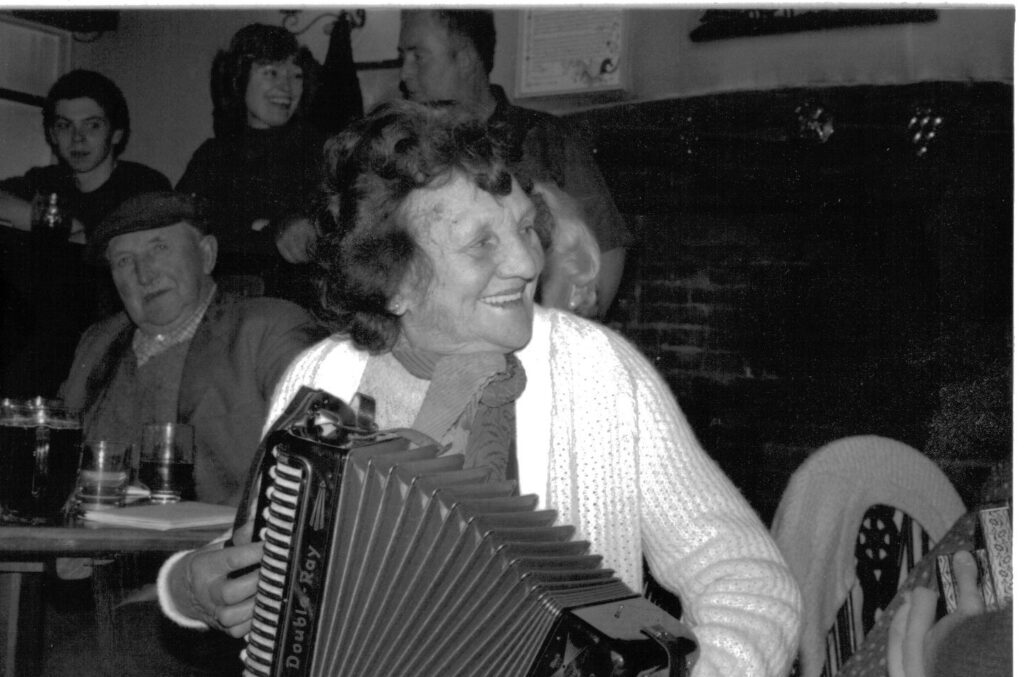
Dolly Curtis 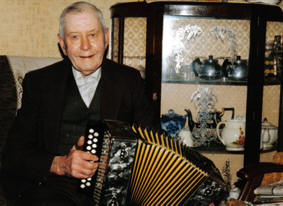
Cecil Pearl 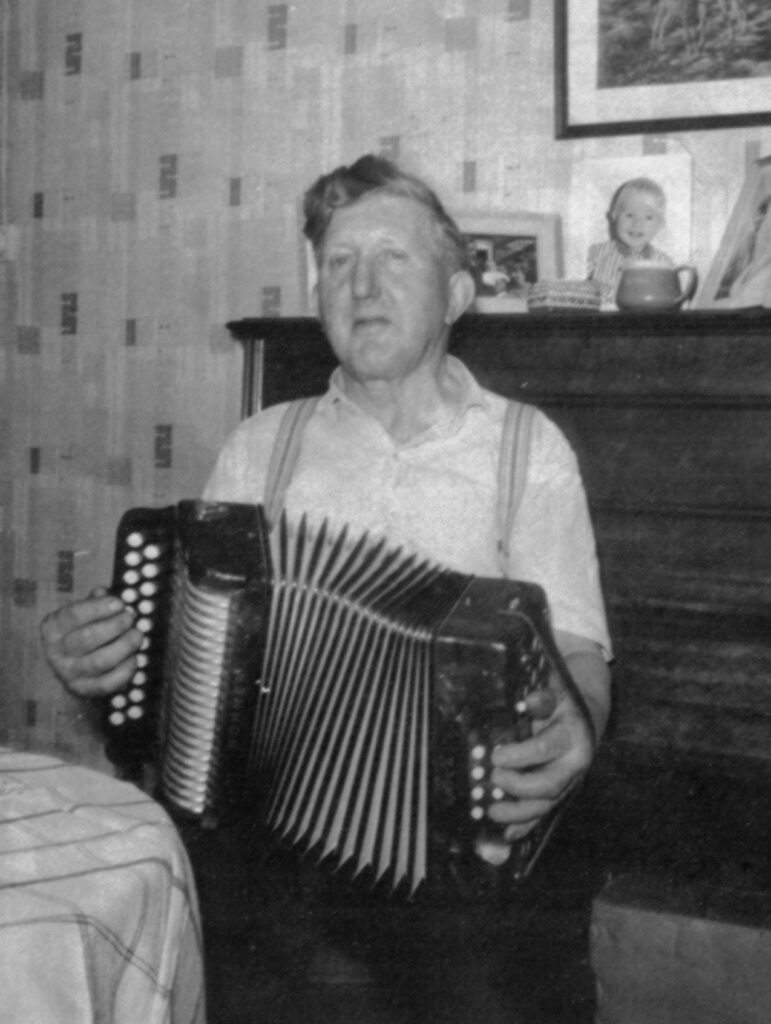
Percy Brown
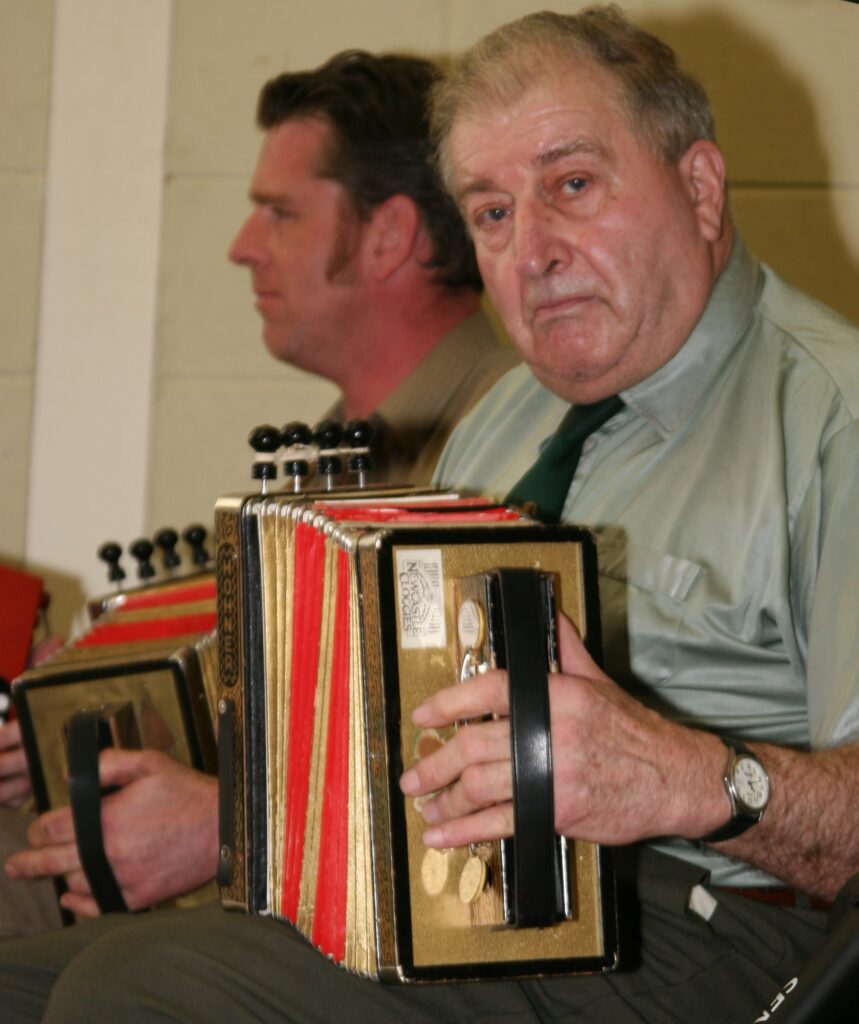
Suffolk musicians Ray Hubbard and Steve Matthews on one row melodeons
Photo credit J Halliday
Recorded by Steve Dumpleton, February 2021
For more information about the tune Oh Joe/Old Joe The Boat is Going Over see Mike Yates’ article on the EATMT website which was originally published on the now defunct Kyloe Records website. Included on this page is a list of the various recordings this tune appears on. You can hear Keith Summers’ recording from the early 1970s of George Woolnough from Saxmundham playing this tune on the British Library Sounds archive HERE.
Oscar Woods was a champion of the one-row four-stop melodeon in the key of C. This instrument deserves a special mention as it perhaps has become the iconic melodeon for traditional East Anglian music. As its name indicates, it has a single row of ten buttons on the right-hand treble side, which can play only notes of the diatonic scale of C major. On the left-hand side there are two spoon-type levers for the basses and chords, producing a bass note and chord of C on the push, and bass and chord of G on the pull. The basses and chords have a deep, growly sound which has sometimes been described as ‘grunt’ and ‘different grunt’! The right-hand treble side is equipped with four knob-like sliding stops which control four banks of reeds: two reeds at pitch, slightly mis-tuned to give the shimmery tremolo, a single bank of reeds tuned an octave lower, and a single bank of piccolo reeds tuned an octave higher. When all four banks of reeds are activated, the resulting sound is gloriously rich and complex.
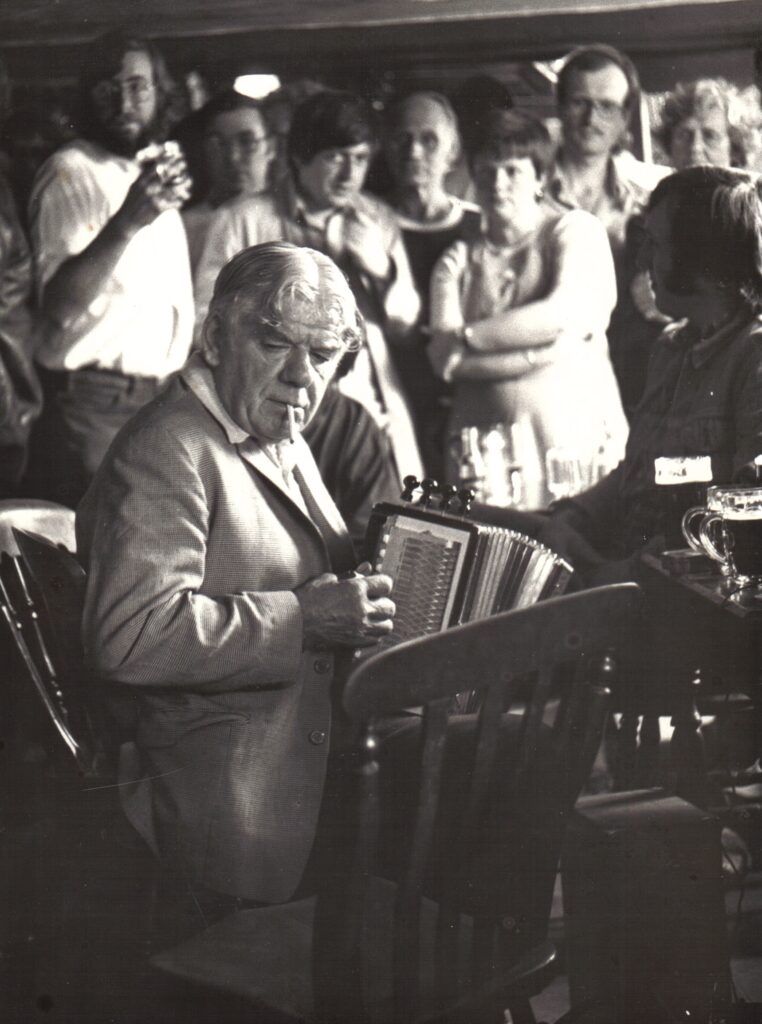
Oscar Woods at the Blaxhall Ship in 1981 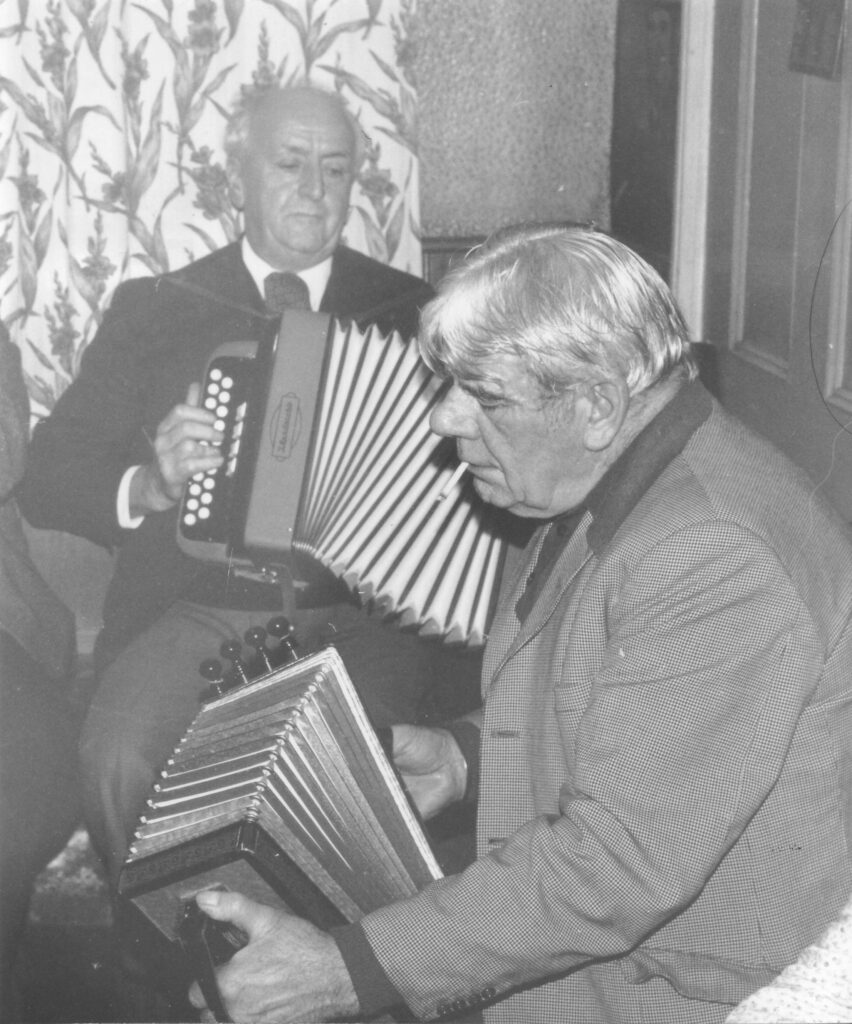
Oscar Woods and Font Whatling
Although it might be thought that the one-row four-stop melodeon is a simple beginner’s instrument, the actual playing technique can be very sophisticated, with right-hand harmonies, and even counter-melodies, supplementing the two left-hand basses and chords.
Melodeons in recent times
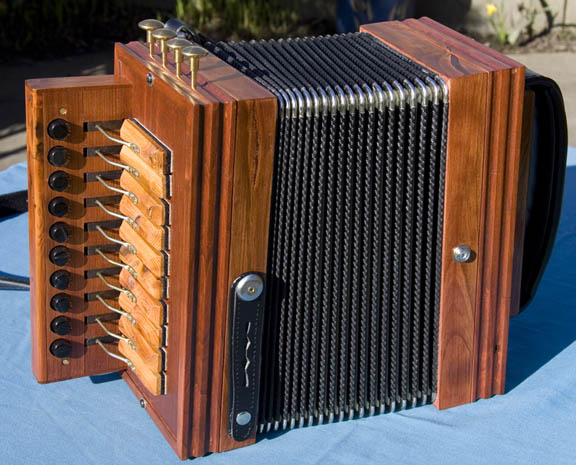
A Wesson ‘Clipper’ one-row four-stop melodeon in C. Made by Rees Wesson, Welshpool, in 2010.
Photo credit S Dumpleton
After the introduction of the D/G melodeon in the 1950s, many melodeon players in England began to abandon the key of C, but in East Anglia it has remained the ‘traditional key’ right up to the present, although sadly declining more and more as players switch to D/G instruments to align themselves with traditional music elsewhere in England. A pity in many ways, as the key of C has a mellower sound compared with its modern, bright-sounding alternative of D. That extra tone shift has made all the difference.
In recent years, the humble Hohner melodeons have gradually declined in both popularity and availability, with newer, more sophisticated (and expensive) instruments, particularly from Italy and France, infiltrating the East Anglian scene. This is not necessarily an undesirable thing, for tradition is also an evolving concept, if it is not to become fossilised and extinct, but together with the decline of the key of C, it has subtly changed the sound of East Anglian traditional music as played on melodeons.
(Above left) A Hohner ‘Erica’ melodeon in D/G, made in Germany. Percy Brown played one like this. (Above right) A modern Italian-made melodeon, a Castagnari ‘1914’ in D/G, made in 2016. The accidentals buttons form the two-button half-row. Photo credits S Dumpleton
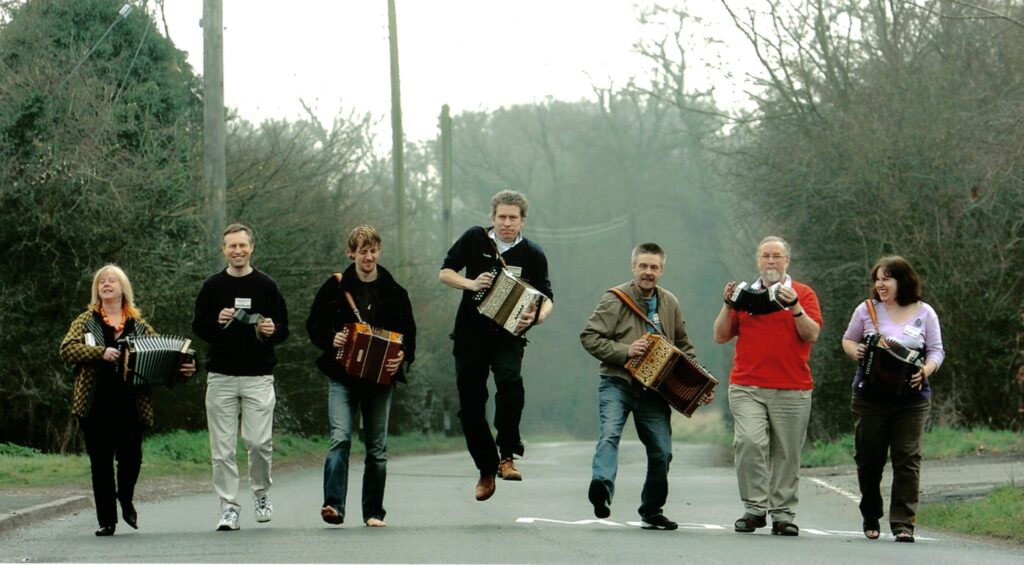
From Melodeons & More 2005, L to R Jeannie Harris, Andy Turner, Tim Van Eyken, Simon Ritchie,
Rees Wesson, Colin Cater and Katie Howson (photo credit Archant Newspapers)
It would not be right to conclude without mentioning a few of the contemporary melodeon players of East Anglian music, and who have influenced my own playing over the years. Rees Wesson (although from Wales!) has promoted and performed East Anglian music for many years and often appears at East Anglian events. He is a skilled melodeon maker and his one-row four-stop instruments are highly praised and sought after. Jeannie Harris is a highly talented singer and one-row player, who has made a particular speciality of the playing style of Oscar Woods. Simon Ritchie is an all-round energetic and talented performer and step dancer, and has played in many bands including the Old Hat Concert Party. Tony Hall is a melodeon player from Norfolk, renowned for his virtuosity on vintage 1930s Hohners; sometimes you could swear there was more than one person playing. There are many other fine players out there. But last, and definitely not least, Katie Howson, former director of EATMT, a wonderful melodeon player on both one-row and two-row instruments, a founder member of the Old Hat Concert Party, and who, through her performing and teaching, has probably has done more than anyone to promote the living tradition of East Anglian melodeon playing.
Tony Hall Photo credit J Halliday Steve Dumpleton Photo credit J Halliday
By Steve Dumpleton
including contributions from Alex Bartholomew and EATMT archives.
FEBRUARY 2021
